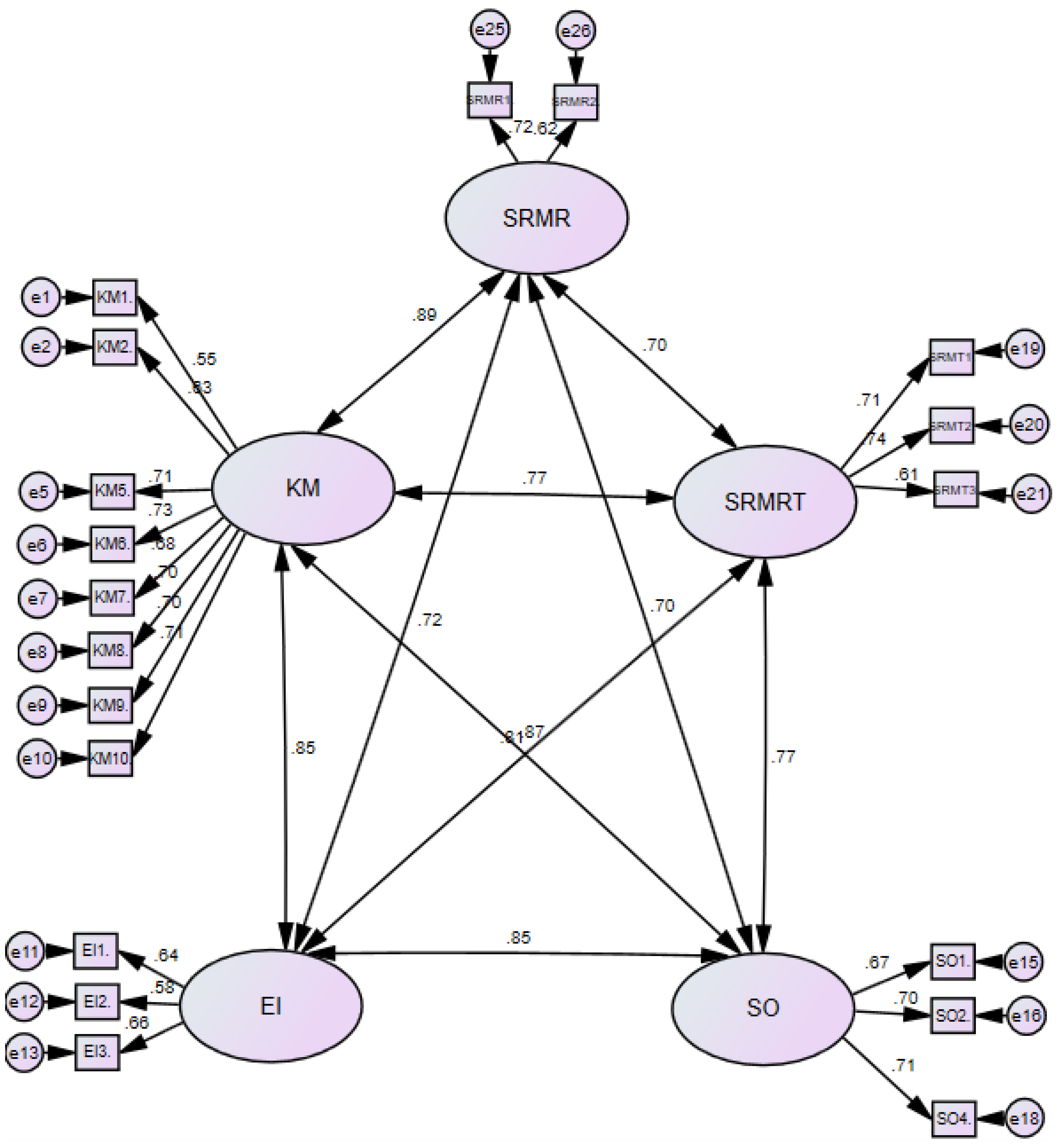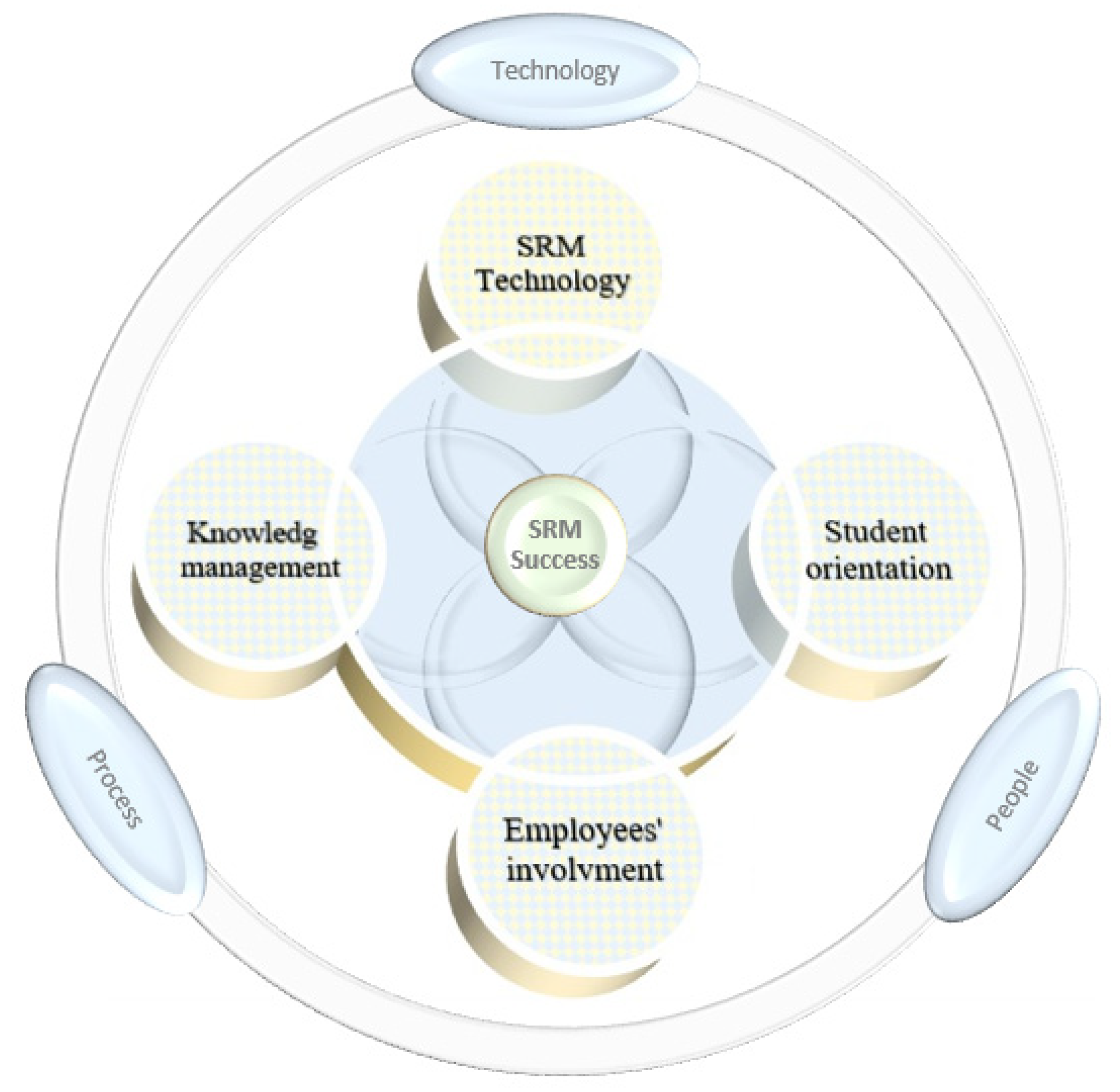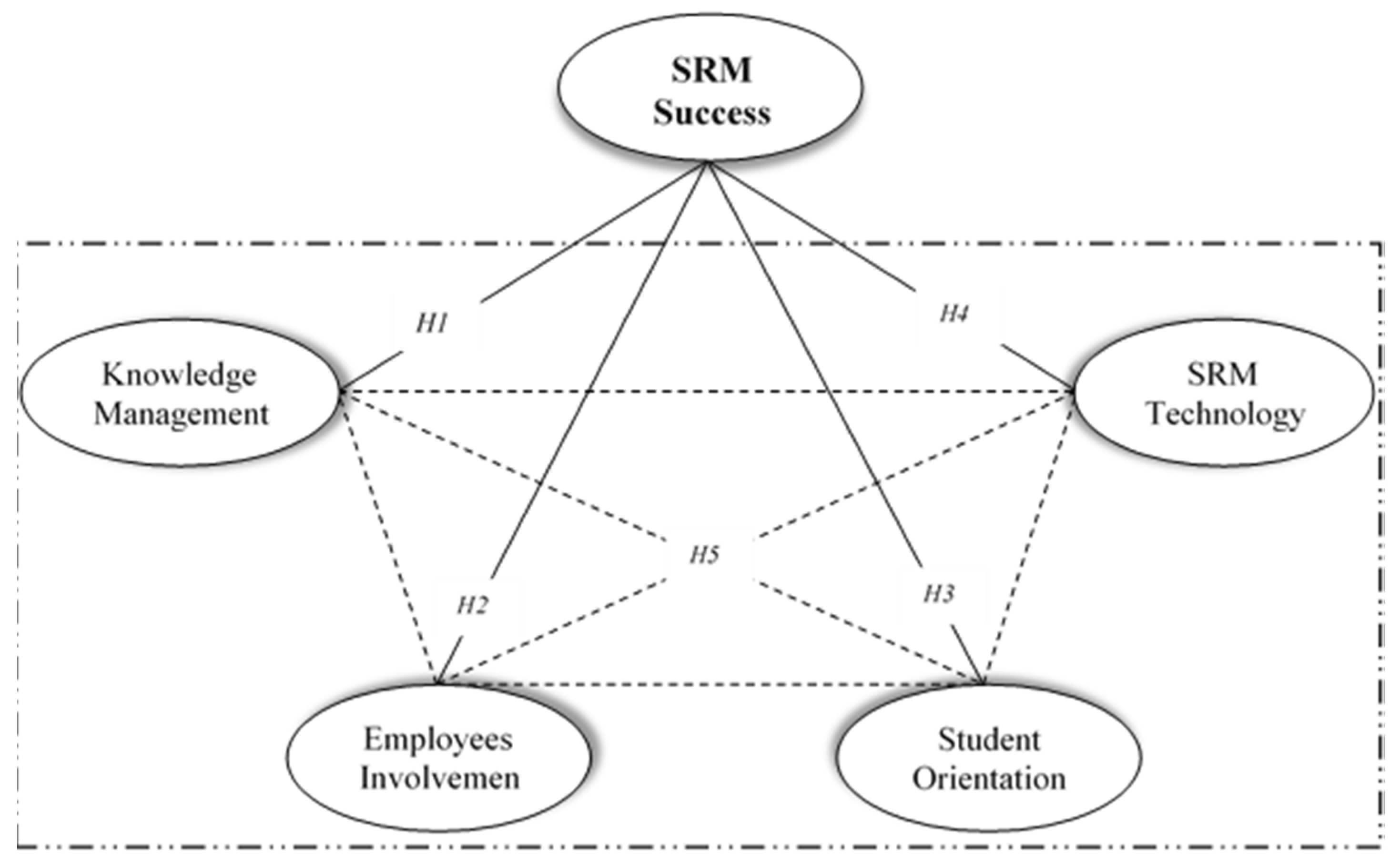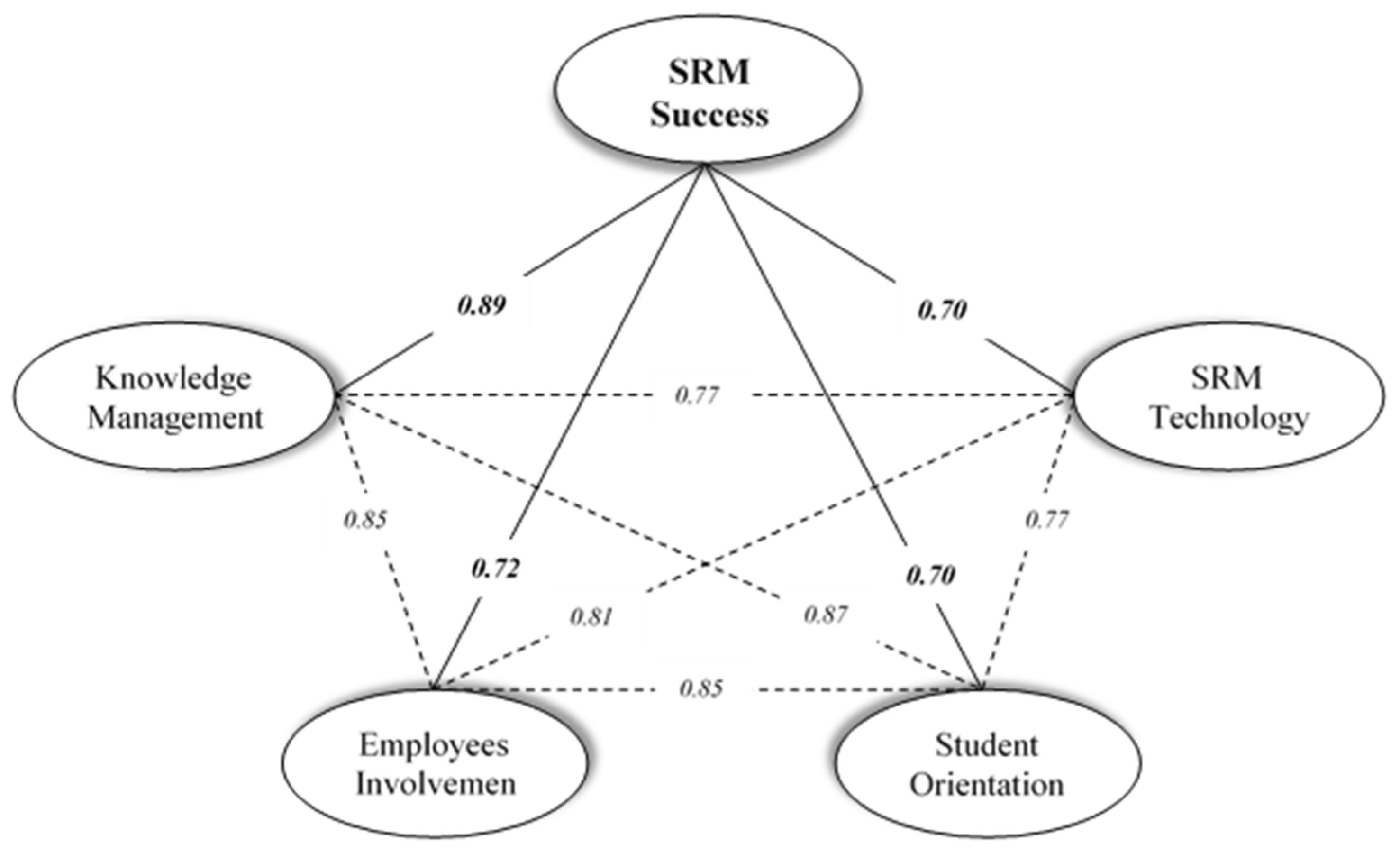Critical Success Factors of Student Relationship Management
Abstract
1. Introduction
2. Literature Review
2.1. Knowledge Management
2.2. Employees’ Involvement
2.3. Student Orientation
2.4. SRM Technology
3. Methods
3.1. Specifying the Measurement Model
3.2. Designing A Confirmatory Survey
3.3. Assessing the Measurement Model Reliability and Validity
4. Results and Discussion
5. Conclusions and Future Research Directions
- The SRM strategy has primarily emerged from the customer relationship management (CRM) theoretical lens (cf. References [7,8,9,10,11,12,13,14,15,16]), implying that students are prime customers of higher education institutions. This issue has clearly been addressed by the findings of References [19,72], stating that the adoption of the student-as-customer perspective by such institutions will contribute to improving “the universities’ service quality” and “the degradation of educational quality in terms of the instructors’ neglect of teaching, the impairment of instructor-student relationship, and the ease of course achievement” [72] and including a “student-centric focus”, “improved customer data and process management”, “increased student loyalty”, “retention”, and “satisfaction with the college’s programs and services” [19].
- Besides, it should be taken into careful consideration that the student relationship is somewhat different from the customer relationship in the industrial and general service sectors. In these sectors, the customers are well-defined while in universities the definition of students as customers is quite broad [73,74]. Although students are recognized as prime customers by many researchers [7,74], due to the dynamic and interactive nature of these institutions, they are also considered as cooperators, co-producers, co-creators of value, and co-developers of knowledge, which reflects a much more important perspective, i.e., the student-as-partner perspective.
Author Contributions
Funding
Acknowledgments
Conflicts of Interest
Appendix A


References
- Carter, S.; Yeo, A.C.M. Students-as-customers’ satisfaction, predictive retention with marketing implications: The case of Malaysian higher education business students. Int. J. Educ. Manag. 2016, 30, 635–652. [Google Scholar] [CrossRef]
- Hilbert, A.; Schönbrunn, K.; Schmode, S. Student relationship management in Germany: Foundations and opportunities. Manag. Rev. 2007, 18, 204–219. [Google Scholar] [CrossRef]
- Buckler, C.; Creech, H. Shaping the Future We Want: UN Decade of Education for Sustainable Development (2005–2014) Final Report; UNESCO: Paris, France, 2014. [Google Scholar]
- Foo, K.Y. A vision on the role of environmental higher education contributing to the sustainable development in Malaysia. J. Clean. Prod. 2013, 61, 6–12. [Google Scholar] [CrossRef]
- Holm, T.; Vuorisalo, T.; Sammalisto, K. Integrated management systems for enhancing education for sustainable development in universities: A memetic approach. J. Clean. Prod. 2015, 106, 155–163. [Google Scholar] [CrossRef]
- Ekman, M.; Lindgren, M.; Packendorff, J. Universities need leadership, academics need management: Discursive tensions and voids in the deregulation of Swedish higher education legislation. High. Educ. 2018, 75, 299–321. [Google Scholar] [CrossRef]
- Gholami, H.; Zameri Mat Saman, M.; Mardani, A.; Streimikiene, D.; Sharif, S.; Zakuan, N. Proposed Analytic Framework for Student Relationship Management based on a Systematic Review of CRM Systems Literature. Sustainability 2018, 10, 1237. [Google Scholar] [CrossRef]
- Ackerman, R.; Schibrowsky, J. A business marketing strategy applied to student retention: A higher education initiative. J. Coll. Stud. Retent. 2007, 9, 307–336. [Google Scholar] [CrossRef]
- Piedade, M.B.; Santos, M.Y. Business intelligence in higher education: Enhancing the teaching-learning process with a SRM system. In Proceedings of the 5th Iberian Conference on Information Systems and Technologies, Santiago de Compostela, Spain, 16–19 June 2010; pp. 1–5. [Google Scholar]
- Shannaq, B.; Rafael, Y.; Alexandro, V. Student relationship in higher education using data mining techniques. Glob. J. Comput. Sci. Technol. 2010, 10, 54–59. [Google Scholar]
- Drapińska, A. A concept of student relationship management in High Education. Prace Instytutu Lotnictwa 2012, 6, 35–49. [Google Scholar]
- Kongsakun, K.; Fung, C.C. Neural Network Modeling for an Intelligent Recommendation System Supporting SRM for Universities in Thailand. WSEAS Trans. Comput. 2012, 11, 34–44. [Google Scholar]
- Lechtchinskaia, L.; Friedrich, I.; Breitner, M.H. Requirements Analysis for a Student Relationship Management System—Results from an Empirical Study in Ivy League Universities. In Proceedings of the IEEE 45th Hawaii International Conference on System Sciences, Washington, DC, USA, 4–7 January 2012; pp. 5132–5141. [Google Scholar]
- Radenković, B.; Despotović-Zrakić, M.; Bogdanović, Z.; Labus, A.; Milutinović, M. Providing services for student relationship management on cloud computing infrastructure. In Proceedings of the IEEE 11th International Conference on Telecommunications in Modern Satellite, Cable and Broadcasting Services (TELSIKS), Nis, Serbia, 16–19 October 2013; Volume 2, pp. 385–388. [Google Scholar]
- Fontaine, M. Student Relationship Management (SRM) in Higher Education: Addressing the Expectations of an Ever Evolving Demographic and Its Impact on Retention. J. Educ. Hum. Dev. 2014, 3, 105–119. [Google Scholar]
- Vulić, M.; Petrović, P.; Kovačević, I.; Živanović, V.R. Student Relationship Management Using Social Clouds. In Handbook of Research on High Performance and Cloud Computing in Scientific Research and Education; IGI Global: Hershey, PA, USA, 2014; pp. 173–194. [Google Scholar]
- Wardley, L.J.; Bélanger, C.H.; Nadeau, J. A co-creation shift in learning management: Work design for institutional commitment and personal growth. High. Educ. 2017, 74, 997–1013. [Google Scholar] [CrossRef]
- Matthews, K.E.; Dwyer, A.; Hine, L.; Turner, J. Conceptions of students as partners. High. Educ. 2018, 76, 1–15. [Google Scholar] [CrossRef]
- Seeman, E.D.; O’Hara, M. Customer relationship management in higher education: Using information systems to improve the student-school relationship. Campus-Wide Inf. Syst. 2006, 23, 24–34. [Google Scholar] [CrossRef]
- Alavi, M.; Leidner, D.E. Review: Knowledge management and knowledge management systems: Conceptual foundations and research issues. MIS Q. 2001, 25, 107–136. [Google Scholar] [CrossRef]
- Huber, G.P. Organizational learning: The contributing processes and the literatures. Organ. Sci. 1991, 2, 88–115. [Google Scholar] [CrossRef]
- Nonaka, I. A dynamic theory of organizational knowledge creation. Organ. Sci. 1994, 5, 14–37. [Google Scholar] [CrossRef]
- Cepeda-Carrion, I.; Martelo-Landroguez, S.; Leal-Rodríguez, A.L.; Leal-Millán, A. Critical processes of knowledge management: An approach toward the creation of customer value. Eur. Res. Manag. Bus. Econ. 2017, 23, 1–7. [Google Scholar] [CrossRef]
- Wong, K.Y.; Tan, L.P.; Lee, C.S.; Wong, W.P. Knowledge Management performance measurement: Measures, approaches, trends and future directions. Inf. Dev. 2015, 31, 239–257. [Google Scholar] [CrossRef]
- Wong, K.Y.; Aspinwall, E. Development of a knowledge management initiative and system: A case study. Expert Syst. Appl. 2006, 30, 633–641. [Google Scholar] [CrossRef]
- Skyrme, D.; Amidon, D. The knowledge agenda. J. Knowl. Manag. 1997, 1, 27–37. [Google Scholar] [CrossRef]
- Beijerse, R.P. Questions in knowledge management: Defining and conceptualising a phenomenon. J. Knowl. Manag. 1999, 3, 94–109. [Google Scholar] [CrossRef]
- Jarrar, Y.F. Knowledge management: Learning for organisational experience. Manag. Audit. J. 2002, 17, 322–328. [Google Scholar] [CrossRef]
- Yang, L.R.; Huang, C.F.; Hsu, T.J. Knowledge leadership to improve project and organizational performance. Int. J. Proj. Manag. 2014, 32, 40–53. [Google Scholar] [CrossRef]
- Lozano, R. Incorporation and institutionalization of SD into universities: Breaking through barriers to change. J. Clean. Prod. 2006, 14, 787–796. [Google Scholar] [CrossRef]
- Tan, C.N.L. Enhancing knowledge sharing and research collaboration among academics: The role of knowledge management. High. Educ. 2016, 71, 525–556. [Google Scholar] [CrossRef]
- Shahbudin, A.S.M.; Nejati, M.; Amran, A. Sustainability-based knowledge management performance evaluation system (SKMPES): Linking the higher learning institutes with the bottom billions. Afr. J. Bus. Manag. 2011, 5, 9530–9540. [Google Scholar]
- Shoham, S.; Perry, M. Knowledge management as a mechanism for technological and organizational change management in Israeli universities. High. Educ. 2009, 57, 227–246. [Google Scholar] [CrossRef]
- Nawaz, M.N.; Gomes, A.M. Review of knowledge management in higher education institutions. Eur. J. Bus. Manag. 2014, 6, 71–79. [Google Scholar]
- Bhusry, M.; Ranjan, J. Implementing knowledge management in higher educational institutions in India: A conceptual framework. Int. J. Comput. Appl. 2011, 29, 34–46. [Google Scholar]
- Sedziuviene, N.; Vveinhardt, J. The paradigm of knowledge management in higher educational institutions. Eng. Econ. 2009, 65, 79–90. [Google Scholar]
- Kidwell, J.J.; Vander, L.K.; Johnson, S.L. Applying corporate knowledge management practices in Higher Education. Educ. Q. 2000, 23, 28–33. [Google Scholar]
- Suciu, M.C.; Piciorus, L.; Imbrisca, C.I. Intellectual capital, trust, cultural traits and reputation in the Romanian education system. Electronic J. Knowl. Manag. 2012, 10, 223–235. [Google Scholar]
- Helm-Stevens, R.; Brown, K.C.; Russell, J.K. Introducing the Intellectual Capital Interplay Model: Advancing Knowledge Frameworks in the Not-for-Profit Environment of Higher Education. Int. Educ. Stud. 2011, 4, 126–140. [Google Scholar]
- Trivella, L.; Dimitrios, N.K. Knowledge management strategy within the High. Educ. The case of Greece. Procedia-Soc. Behav. Sci. 2015, 175, 488–495. [Google Scholar] [CrossRef]
- Charles, W.; Nawe, J. Knowledge Management (KM) Practices in Institutions of Higher Learning in Tanzania with Reference to Mbeya University of Science and Technology. Univ. Dar es Salaam Libr. J. 2017, 12, 48–65. [Google Scholar]
- Cranfield, D.J.; Taylor, J. Knowledge management and higher education: A UK case study. Electronic J. Knowl. Manag. 2008, 6, 85–100. [Google Scholar]
- Rees, S.J.; Protheroe, H. Value, Kaizen and Knowledge Management: Developing a Knowledge Management Strategy for Southampton Solent University. The Electronic J. Knowl. Manag. 2009, 7, 135–144. [Google Scholar]
- Tariq, S.; Jan, F.A.; Ahmad, M.S. Green employee empowerment: A systematic literature review on state-of-art in green human resource management. Qual. Quant. 2016, 50, 237–269. [Google Scholar] [CrossRef]
- Maslach, C.; Schaufeli, W.B.; Leiter, M.P. Job burnout. Annu. Rev. Psychol. 2001, 52, 397–422. [Google Scholar] [CrossRef] [PubMed]
- Schaufeli, W.B.; Salanova, M.; González-Romá, V.; Bakker, A.B. The measurement of engagement and burnout: A two sample confirmatory factor analytic approach. J. Happiness Stud. 2002, 3, 71–92. [Google Scholar] [CrossRef]
- Gruman, J.A.; Saks, A.M. Performance management and employee engagement. Hum. Resour. Manag. Rev. 2011, 21, 123–136. [Google Scholar] [CrossRef]
- Harer, J.K.; Schmidt, F.L.; Hayes, T.L. Business-unit-level relationship between employee satisfaction, employee engagement, and business outcomes: A meta-analysis. J. Appl. Psychol. 2002, 87, 268–279. [Google Scholar] [CrossRef]
- Kompaso, S.M.; Sridevi, M.S. Employee engagement: The key to improving performance. Int. J. Bus. Manag. 2010, 5, 89–96. [Google Scholar] [CrossRef]
- Macey, W.H.; Schneider, B.; Barbera, K.M.; Young, S.A. Employee Engagement: Tools for Analysis, Practice, and Competitive Advantage; Wiley-Blackwell: Malden, WA, USA, 2009. [Google Scholar]
- Kyndt, E.; Baert, H. Antecedents of employees’ involvement in work-related learning: A systematic review. Rev. Educ. Res. 2013, 83, 273–313. [Google Scholar] [CrossRef]
- Davies, I.A.; Crane, A. Corporate social responsibility in small-and medium-size enterprises: Investigating employee engagement in fair trade companies. Bus. Ethics: A Eur. Rev. 2010, 19, 126–139. [Google Scholar] [CrossRef]
- Rezaei, G.; Gholami, H.; Shaharou, A.B.M.; Saman, M.Z.M.; Zakuan, N.; Najmi, M. Relationship among culture of excellence, organisational performance and knowledge sharing: Proposed conceptual framework. Int. J. Prod. Qual. Manag. 2016, 19, 446–465. [Google Scholar] [CrossRef]
- Lindner, F.; Wald, A. Success factors of knowledge management in temporary organizations. Int. J. Proj. Manag. 2011, 29, 877–888. [Google Scholar] [CrossRef]
- Curran, R. Students as Partners—Good for Students, Good for Staff: A Study on the Impact of Partnership Working and How This Translates to Improved Student-Staff Engagement. Int. J. Stud. Partn. 2017, 1, 1–16. [Google Scholar] [CrossRef]
- Garrido-Moreno, A.; Padilla-Meléndez, A. Analyzing the impact of knowledge management on CRM success: The mediating effects of organizational factors. Int. J. Inf. Manag. 2011, 31, 437–444. [Google Scholar] [CrossRef]
- Abdullateef, A.O.; Salleh, S.M. Does customer relationship management influence call centre quality performance? An empirical industry analysis. Total Qual. Manag. Bus. Excell. 2013, 24, 1035–1045. [Google Scholar] [CrossRef]
- Narver, J.C.; Slater, F.S. The effect of a market orientation on business profitability. J. Mark. 1990, 54, 20–35. [Google Scholar] [CrossRef]
- Bentum, R.V.; Stone, M. Customer relationship management and the impact of corporate culture—A European study. J. Database Mark. Cust. Strategy Manag. 2005, 13, 28–54. [Google Scholar] [CrossRef][Green Version]
- Brown, R.M.; Mazzarol, T.W. The importance of institutional image to student satisfaction and loyalty within higher education. High. Educ. 2009, 58, 81–95. [Google Scholar] [CrossRef]
- Dužević, I.; Časni, A.Č. Student and faculty perceptions of service quality: The moderating role of the institutional aspects. High. Educ. 2015, 70, 567–584. [Google Scholar] [CrossRef]
- Sin, L.Y.; Tse, A.C.; Yim, F.H. CRM: Conceptualization and scale development. Eur. J. Mark. 2005, 39, 1264–1290. [Google Scholar] [CrossRef]
- Hair, J.F.; Black, W.C.; Babin, B.J.; Anderson, R.E. Multivariate Data Analysis: A Global Perspective, 7th ed.; Pearson-Hall International: Upper Saddle River, NJ, USA, 2010. [Google Scholar]
- Schreiber, J.B.; Nora, A.; Stage, F.K.; Barlow, E.A.; King, J. Reporting structural equation modeling and confirmatory factor analysis results: A review. J. Educ. Res. 2006, 99, 323–337. [Google Scholar] [CrossRef]
- Albright, J.J.; Park, H.M. Confirmatory factor analysis using Amos, LISREL, Mplus, and SAS/STAT CALIS; Working Paper; The Trustees of Indiana University: Indianapolis, IN, USA, 2009; Volume 1, pp. 1–85. [Google Scholar]
- Costa, D.R.; Lachos, V.H.; Bazan, J.L.; Azevedo, C.L. Estimation methods for multivariate Tobit confirmatory factor analysis. Comput. Stat. Data Anal. 2014, 79, 248–260. [Google Scholar] [CrossRef]
- Nejati, M.; Nejati, M. Assessment of sustainable university factors from the perspective of university students. J. Clean. Prod. 2013, 48, 101–107. [Google Scholar] [CrossRef]
- Forza, C. Survey research in operations management: A process-based perspective. Int. J. Oper. Prod. Manag. 2002, 22, 152–194. [Google Scholar] [CrossRef]
- Gayles, J.G.; Rockenbach, A.B.; Davis, H.A. Civic responsibility and the student athlete: Validating a new conceptual model. J. High. Educ. 2012, 83, 535–557. [Google Scholar] [CrossRef]
- Rezaei, G.; Gholami, H.; Shaharou, A.B.M.; Zameri Mat Saman, M.; Sadeghi, L.; Zakuan, N. Shared knowledge mediated correlation between cultural excellence and organisational performance. Total Qual. Manag. Bus. Excell. 2017, 28, 427–458. [Google Scholar] [CrossRef]
- Gholami, H.; Rezaei, G.; Saman, M.Z.M.; Sharif, S.; Zakuan, N. State-of-the-art Green HRM System: Sustainability in the sports center in Malaysia using a multi-methods approach and opportunities for future research. J. Clean. Prod. 2016, 124, 142–163. [Google Scholar] [CrossRef]
- Watjatrakul, B. Factors affecting students’ intentions to study at universities adopting the “student-as-customer” concept. Int. J. Educ. Manag. 2014, 28, 676–693. [Google Scholar] [CrossRef]
- Madu, C.N.; Chu-Hua, K. Dimensions of quality teaching in higher institutions. Total Qual. Manag. 1993, 4, 325–338. [Google Scholar] [CrossRef]
- Mandaviya, M.; Dwivedi, V.V. A critical review on paradigms of sustainable development in higher education: An international perspective. Int. J. Appl. Res. 2016, 2, 312–320. [Google Scholar]



| Fit index | Value | Criterion | |
|---|---|---|---|
| Initial CFA | Revised CFA | ||
| Ratio of chi-square to its degree of freedom (CMIN/DF) | 648.375/289 = 2.244 | 189.158/140 = 1.351 | <3 |
| Comparative fit index (CFI) | 0.844 | 0.972 | >0.90 |
| Non-normed fit index (NNFI) | 0.825 | 0.965 | >0.90 |
| Incremental fit index (IFI) | 0.847 | 0.972 | >0.90 |
| Goodness of fit index (GFI) | 0.802 | 0.922 | >0.90 |
| Adjusted goodness of fit index (AGFI) | 0.759 | 0.894 | >0.80 |
| Root mean square residual (RMR) | 0.068 | 0.040 | <0.05 |
| Root mean squared error of approximation (RMSEA) (90% Confidence Interval) | 0.074 (0.066–0.081) | 0.039 (0.02–0.05) | <0.08 |
| PCLOSE | 0.000 | 0.904 | >0.05 |
| SRM Critical Success Factors | Correlation | SRM Success | Type of Correlation |
|---|---|---|---|
| Knowledge Management | Correlation coefficient p-value (Sig.) | 0.886 p < 0.001 | Significant |
| Employees Involvement | Correlation coefficient p-value (Sig.) | 0.715 p < 0.001 | Significant |
| Student Orientation | Correlation coefficient p-value (Sig.) | 0.704 p < 0.001 | Significant |
| SRM Technology | Correlation coefficient p-value (Sig.) | 0.696 p < 0.001 | Significant |
| SRM Critical Success Factors | Correlation | Knowledge Management | Employees Involvement | Student Orientation |
|---|---|---|---|---|
| Employees Involvement | Correlation coefficient p-value (Sig.) | 0.854 p < 0.001 | ||
| Student Orientation | Correlation coefficient p-value (Sig.) | 0.869 p < 0.001 | 0.850 p < 0.001 | |
| SRM Technology | Correlation coefficient p-value (Sig.) | 0.767 p < 0.001 | 0.812 p < 0.001 | 0.765 p < 0.001 |
© 2018 by the authors. Licensee MDPI, Basel, Switzerland. This article is an open access article distributed under the terms and conditions of the Creative Commons Attribution (CC BY) license (http://creativecommons.org/licenses/by/4.0/).
Share and Cite
Gholami, H.; Saman, M.Z.M.; Sharif, S.; Zakuan, N.; Abu, F.; Awang, S.R. Critical Success Factors of Student Relationship Management. Sustainability 2018, 10, 4527. https://doi.org/10.3390/su10124527
Gholami H, Saman MZM, Sharif S, Zakuan N, Abu F, Awang SR. Critical Success Factors of Student Relationship Management. Sustainability. 2018; 10(12):4527. https://doi.org/10.3390/su10124527
Chicago/Turabian StyleGholami, Hamed, Muhamad Zameri Mat Saman, Safian Sharif, Norhayati Zakuan, Falah Abu, and Siti Rahmah Awang. 2018. "Critical Success Factors of Student Relationship Management" Sustainability 10, no. 12: 4527. https://doi.org/10.3390/su10124527
APA StyleGholami, H., Saman, M. Z. M., Sharif, S., Zakuan, N., Abu, F., & Awang, S. R. (2018). Critical Success Factors of Student Relationship Management. Sustainability, 10(12), 4527. https://doi.org/10.3390/su10124527








